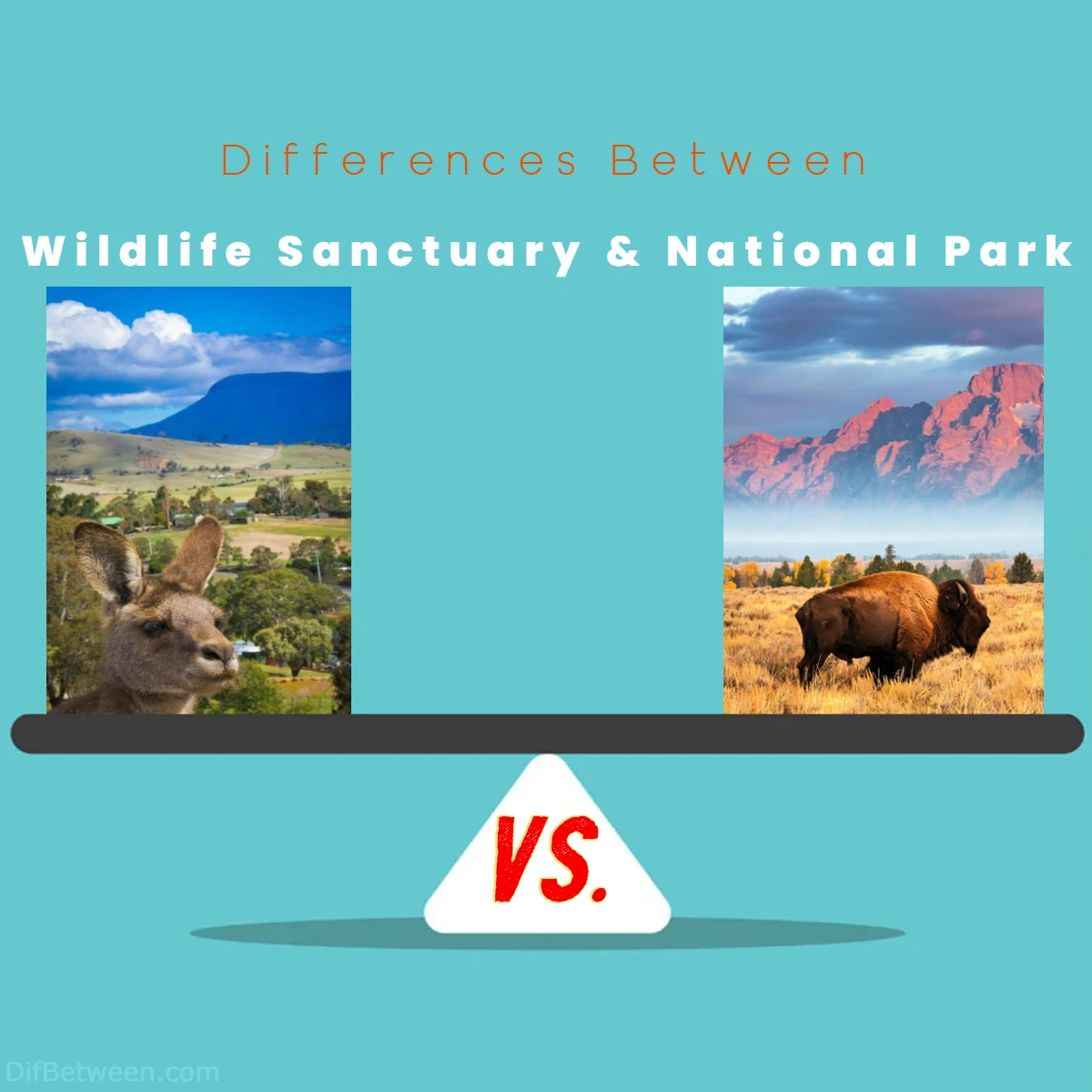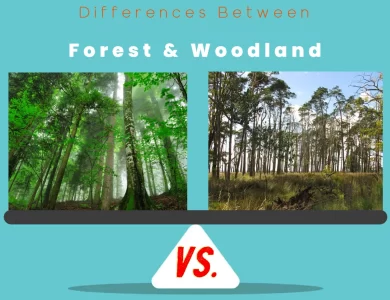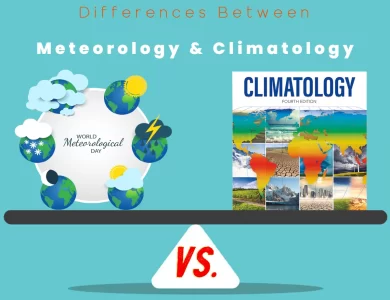
| Aspect | Wildlife Sanctuary | National Park |
|---|---|---|
| Purpose | Protect endangered species and habitats | Preserve entire ecosystems and landscapes |
| Focus | Specific species and their conservation | Biodiversity, ecological integrity |
| Human Activities | Restricted to minimize disturbances | Controlled activities for recreation |
| Management Approach | Species-centric, minimal human intervention | Holistic preservation, public access |
| Conservation Emphasis | Endangered species, anti-poaching efforts | Biodiversity, cultural heritage, education |
| Research | Focus on species behavior, health, and breeding | Comprehensive ecological and cultural |
| Community Involvement | Limited, often focused on collaboration | Can involve local communities and tourism |
| Accessibility | Limited public access to protect species | Controlled public access, recreation |
| Visitor Engagement | Minimal, research and education-focused | Balanced engagement, public awareness |
| Legal Designation | Varies by region, less standardized recognition | Specific legal measures for protection |
| International Status | Limited recognition, species-dependent | Higher recognition, global significance |
| Biodiversity Focus | Protect specific species, contribute to biodiversity | Preserve diverse ecosystems, keystone species |
| Ecological Research | Supports target species, limited ecosystem-scale study | Comprehensive ecological research |
| Public Access | Limited access to protect species | Controlled access for recreation, education |
| Visitor Engagement | Minimal, research and education-focused activities | Balanced engagement, public awareness |
Nestled within the verdant embrace of wildlife sanctuaries, a delicate balance is struck between the whispering wind and the delicate dance of endangered species. These sanctuaries stand as nature’s fortresses, offering a respite from human disruptions, enabling our animal companions to thrive and flourish. On the other hand, the grandeur of national parks beckons with open arms – a sanctuary for ecosystems, where landscapes ranging from towering mountains to meandering rivers tell tales of geological wonders and thriving life forms.
Differences Between Wildlife Sanctuary and National Park
The main differences between a Wildlife Sanctuary and a National Park lie in their primary purpose and focus. A Wildlife Sanctuary is primarily established to provide a safe haven for specific species, particularly those facing threats of extinction. It aims to protect these species from hunting, poaching, and habitat degradation while limiting human disturbances. On the other hand, a National Park focuses on the preservation of entire ecosystems, including landscapes, flora, fauna, and geological formations. While it allows controlled human activities like recreation and education, its overarching goal is to maintain the ecological and cultural integrity of diverse environments. In essence, Wildlife Sanctuaries prioritize species protection, while National Parks emphasize holistic ecosystem conservation and public engagement.
Purpose and Focus
Wildlife Sanctuary
Imagine a haven where nature’s inhabitants can thrive without the pressures of human interference. That’s the essence of a wildlife sanctuary. These sanctuaries are designed to provide a safe haven for animals, birds, and other living beings, allowing them to flourish in their natural habitats without disruptions. The primary purpose of a wildlife sanctuary is to offer refuge to endangered species, migratory birds, and animals that need protection from hunting, poaching, and habitat degradation.
Wildlife sanctuaries often serve as crucial breeding grounds and resting places for animals during migration. They provide a space for animals to breed, rear their young, and find shelter from adverse conditions. These sanctuaries can encompass a range of ecosystems, from forests and grasslands to wetlands and coastal areas. Their management focuses on maintaining a balance between conserving biodiversity and minimizing human impact.
National Park
Now, picture a vast expanse of untouched wilderness, where landscapes paint a canvas of nature’s splendor, unspoiled by human development. This is the heart of a national park. National parks are dedicated to the preservation of both natural and cultural resources. Their primary purpose is to safeguard entire ecosystems, including landscapes, flora, fauna, and geological formations. Unlike wildlife sanctuaries, which often prioritize the protection of specific species, national parks emphasize the holistic preservation of diverse ecosystems.
National parks are often cherished for their scenic beauty, recreational opportunities, and educational value. They aim to strike a balance between allowing public access for enjoyment and minimizing human impact on the environment. While some human activities may be permitted within designated areas of a national park, the overarching goal remains the protection of its ecological and cultural integrity.
Regulations and Human Activities
Wildlife Sanctuary
In the tranquil realm of wildlife sanctuaries, the focus is on minimizing human disturbances to create a safe space for wildlife. As a result, activities that could disrupt the natural balance are often restricted. While specific regulations may vary, wildlife sanctuaries generally limit activities like hunting, logging, and industrial development. This stringent approach ensures that animals can go about their lives without undue stress.
Most wildlife sanctuaries place a strong emphasis on scientific research and conservation efforts. Researchers are given the opportunity to study and monitor the behavior, health, and breeding patterns of various species within the sanctuary’s boundaries. This knowledge informs conservation strategies and contributes to a deeper understanding of the delicate ecosystems in place.
National Park
National parks, while equally committed to conservation, often have a broader scope that accommodates a wider range of human activities. These activities can include hiking, camping, birdwatching, and even controlled tourism. However, it’s important to note that these activities are typically regulated to ensure they do not harm the park’s ecosystems.
In national parks, designated zones may allow for controlled tourism to promote environmental awareness and appreciation. Interpretive centers, guided tours, and educational programs offer visitors the chance to connect with nature while learning about the park’s unique features. Striking a balance between visitor enjoyment and environmental protection remains a central challenge for the management of national parks.
Management Strategies
Wildlife Sanctuary
The management of wildlife sanctuaries is driven by the singular goal of providing a safe haven for vulnerable species. Conservation efforts are laser-focused on the needs of these species, often employing tactics like habitat restoration, anti-poaching measures, and wildlife rehabilitation. The management approach is geared towards minimal human intervention and disturbance.
Local communities and indigenous populations living around wildlife sanctuaries might have limited access to these areas to ensure minimal disruption to the animal populations. Collaborative efforts with these communities may involve training in sustainable practices and wildlife monitoring, fostering a sense of shared responsibility for conservation.
National Park
National parks adopt a more comprehensive approach to conservation and management. They consider not only the protection of wildlife and ecosystems but also the broader cultural and historical significance of the area. Management strategies include habitat restoration, wildlife monitoring, and enforcing regulations to control human activities. However, a greater degree of public access is often permitted in national parks.
The management of national parks often involves striking a delicate balance between preserving natural integrity and accommodating recreational and educational activities. This might include setting visitor limits in sensitive areas, establishing camping and picnic zones, and maintaining trails that allow for safe exploration while minimizing ecological impact.
Biodiversity and Ecological Significance
Wildlife Sanctuary
Within the boundaries of a wildlife sanctuary, biodiversity takes center stage. These sanctuaries are often established in regions that are home to a wide variety of flora and fauna, especially those species that are facing threats of extinction. By focusing on protecting these vulnerable species, wildlife sanctuaries contribute significantly to the overall biodiversity of the area.
The absence of human disturbances in wildlife sanctuaries allows for the natural ecological processes to unfold undisturbed. Predators and prey interact in a balanced manner, vegetation thrives without the pressures of habitat destruction, and migratory species find safe stopovers during their journeys. This undisturbed environment supports not only the target species but also the intricate web of life that they are a part of.
National Park
While biodiversity is also a crucial aspect of national parks, these protected areas encompass a broader range of ecosystems and habitats. This diversity allows for the preservation of entire landscapes, including forests, grasslands, mountains, wetlands, and more. National parks often serve as living laboratories where researchers can study the interactions between various species and their environment on a larger scale.
National parks play a significant role in conserving keystone species, which have a disproportionate impact on their ecosystem. By protecting these species, national parks help maintain the ecological balance and health of the entire region. The variety of ecosystems within a national park allows for a more comprehensive understanding of ecological processes and how they contribute to the planet’s overall well-being.
Accessibility and Public Engagement
Wildlife Sanctuary
Wildlife sanctuaries, due to their primary focus on minimizing human disturbances, often limit public access. While these areas may allow for some controlled research and educational activities, they prioritize the well-being of the resident species over visitor engagement. The tranquility of these spaces provides a retreat for wildlife to thrive away from the pressures of human activity.
The restricted access to wildlife sanctuaries is a testament to the commitment of these areas to serve as safe havens for endangered and sensitive species. While the public might not have extensive opportunities to explore these sanctuaries, their existence is a reminder of the importance of protecting critical habitats and allowing wildlife to flourish without direct human intervention.
National Park
National parks strike a delicate balance between conservation and public engagement. Many national parks are designed to allow visitors to experience the wonders of nature firsthand. This accessibility promotes a deeper connection between people and the environment, fostering a sense of stewardship and appreciation for the natural world.
Visitor centers, interpretive programs, guided tours, and well-maintained trails offer avenues for education and recreation within national parks. These activities are carefully managed to ensure that they do not harm the ecological integrity of the park. By welcoming the public, national parks raise awareness about the importance of conservation and encourage sustainable practices that can extend beyond park boundaries.
Legal Designation and International Recognition
Wildlife Sanctuary
The designation of a wildlife sanctuary varies from country to country. In some regions, wildlife sanctuaries might have specific legal protections, while in others, they could be established through community agreements or government declarations. The level of protection provided to these areas often depends on the specific threats faced by the species they aim to protect.
On the international stage, wildlife sanctuaries might be recognized as important areas for biodiversity conservation, especially if they harbor critically endangered species. However, the level of recognition can vary, and these areas may not always receive the same level of attention as other types of protected areas.
National Park
National parks generally hold a higher level of legal recognition and protection. They are often established through specific legislative measures that provide a framework for their management, conservation goals, and public access regulations. This legal designation elevates the status of national parks and underscores their significance in preserving natural and cultural heritage.
Internationally, national parks often receive more widespread recognition and support. Organizations like the International Union for Conservation of Nature (IUCN) categorize national parks as Category II protected areas, highlighting their importance on a global scale. This recognition can attract funding, research efforts, and collaborative initiatives aimed at safeguarding these ecologically significant regions.
Wildlife Sanctuary or National Park: Which One is Right Choose for You?
Are you ready to embark on a nature-filled journey but find yourself torn between the allure of a wildlife sanctuary and the enchantment of a national park? Choosing the right conservation area for your adventure involves considering your interests, priorities, and the type of experience you seek. Let’s delve into the factors that can help you make the decision that aligns with your preferences.
Wildlife Sanctuary: A Haven for Species Enthusiasts
If you’re an avid wildlife enthusiast or a passionate birdwatcher, a wildlife sanctuary might be the perfect choice for you. These protected areas focus on providing a safe haven for specific species, often those facing threats of extinction. By opting for a wildlife sanctuary, you’ll immerse yourself in an environment dedicated to the protection and conservation of these creatures.
Why Choose a Wildlife Sanctuary:
- Species-Centric Experience: Wildlife sanctuaries offer the chance to observe and appreciate rare and endangered species up close, fostering a deeper connection with their plight and the importance of their conservation.
- Peaceful Retreat: With limited human disturbances, wildlife sanctuaries provide a tranquil setting for those seeking solitude and a break from the hustle and bustle of everyday life.
- Scientific Insights: If you’re intrigued by animal behavior and conservation research, wildlife sanctuaries often facilitate opportunities to learn from experts and contribute to ongoing studies.
National Park: A Window to Ecological Diversity
For those who yearn to explore a variety of landscapes, from towering mountains to serene wetlands, national parks offer a diverse tapestry of nature’s wonders. National parks emphasize the preservation of entire ecosystems and the interactions between different species, making them ideal for nature enthusiasts who want to experience a holistic view of the environment.
Why Choose a National Park:
- Ecosystem Exploration: National parks provide a canvas of ecosystems, allowing you to hike through lush forests, gaze upon breathtaking vistas, and witness the intricate web of life in action.
- Educational Adventures: With visitor centers, guided tours, and educational programs, national parks offer opportunities to learn about the geological, ecological, and cultural significance of the area.
- Outdoor Activities: If you’re an adventure seeker or a recreationalist, national parks often permit activities like camping, hiking, and photography that let you fully immerse yourself in the natural beauty.
Making the Choice
When making your decision, consider the following questions:
- What is Your Focus? Are you more interested in specific species or a wide range of ecosystems? Do you want to witness the behaviors of rare animals or explore diverse landscapes?
- What Experience Do You Seek? Are you looking for a serene escape to connect with nature, or do you want an active outdoor adventure that involves various activities?
- How Important is Public Access? Do you prefer limited access to ensure the well-being of species, or do you want the chance to engage with other visitors and participate in educational programs?
- What Message Do You Want to Support? Wildlife sanctuaries emphasize the conservation of endangered species, while national parks focus on preserving biodiversity and educating the public. What cause resonates with you?
Both wildlife sanctuaries and national parks contribute significantly to the conservation of our planet’s natural heritage. The choice ultimately boils down to your personal interests, desired experiences, and the impact you hope to make through your adventure. Whether you choose to embark on a journey of discovery in a tranquil sanctuary or explore the diverse wonders of a national park, the natural world eagerly awaits your exploration.
FAQs
The primary difference lies in their focus and purpose. A Wildlife Sanctuary is established to protect specific species, particularly those at risk of extinction, by providing a safe habitat free from disturbances. In contrast, a National Park aims to preserve entire ecosystems, including landscapes, flora, fauna, and geological features, while also allowing controlled human activities.
Certainly. Wildlife Sanctuaries place a strong emphasis on protecting endangered species from threats like hunting and habitat destruction. They often implement measures to prevent disturbances to these species. National Parks, on the other hand, focus on conserving biodiversity, ecological integrity, and cultural heritage. They aim to maintain the balance of diverse ecosystems while allowing visitors to enjoy and learn from the environment.
Yes, but to varying degrees. In Wildlife Sanctuaries, human activities are restricted to minimize disturbances to the protected species. These areas prioritize the well-being of animals. In National Parks, controlled human activities like hiking, camping, and educational programs are permitted, but they are carefully managed to ensure minimal impact on the ecosystems.
Wildlife Sanctuaries often have limited public access to protect the species they house. The focus is on providing a safe space for animals to thrive without human interference. National Parks, while also focused on conservation, generally offer controlled public access to allow visitors to appreciate and learn about the diverse landscapes and ecosystems.
In Wildlife Sanctuaries, research tends to be species-centric, focusing on the behavior, health, and breeding patterns of the protected species. This knowledge informs conservation strategies. In National Parks, research is broader and encompasses ecological studies to understand interactions within entire ecosystems, including flora, fauna, and geological features.
Wildlife Sanctuaries might receive limited international recognition, particularly if they house critically endangered species. National Parks, due to their broader focus on ecosystem preservation, tend to have higher international recognition and may attract global support and collaboration for their conservation efforts.
If you’re keen on observing and supporting specific endangered species, a Wildlife Sanctuary is the ideal choice. These sanctuaries provide a dedicated environment for these species to thrive, while also offering opportunities for conservation-focused activities and education.
For a holistic nature adventure encompassing diverse ecosystems, landscapes, and educational opportunities, a National Park is the way to go. These parks allow controlled recreation, offer guided tours, and showcase the interconnectedness of various species within their habitats.
Read More:
Contents






